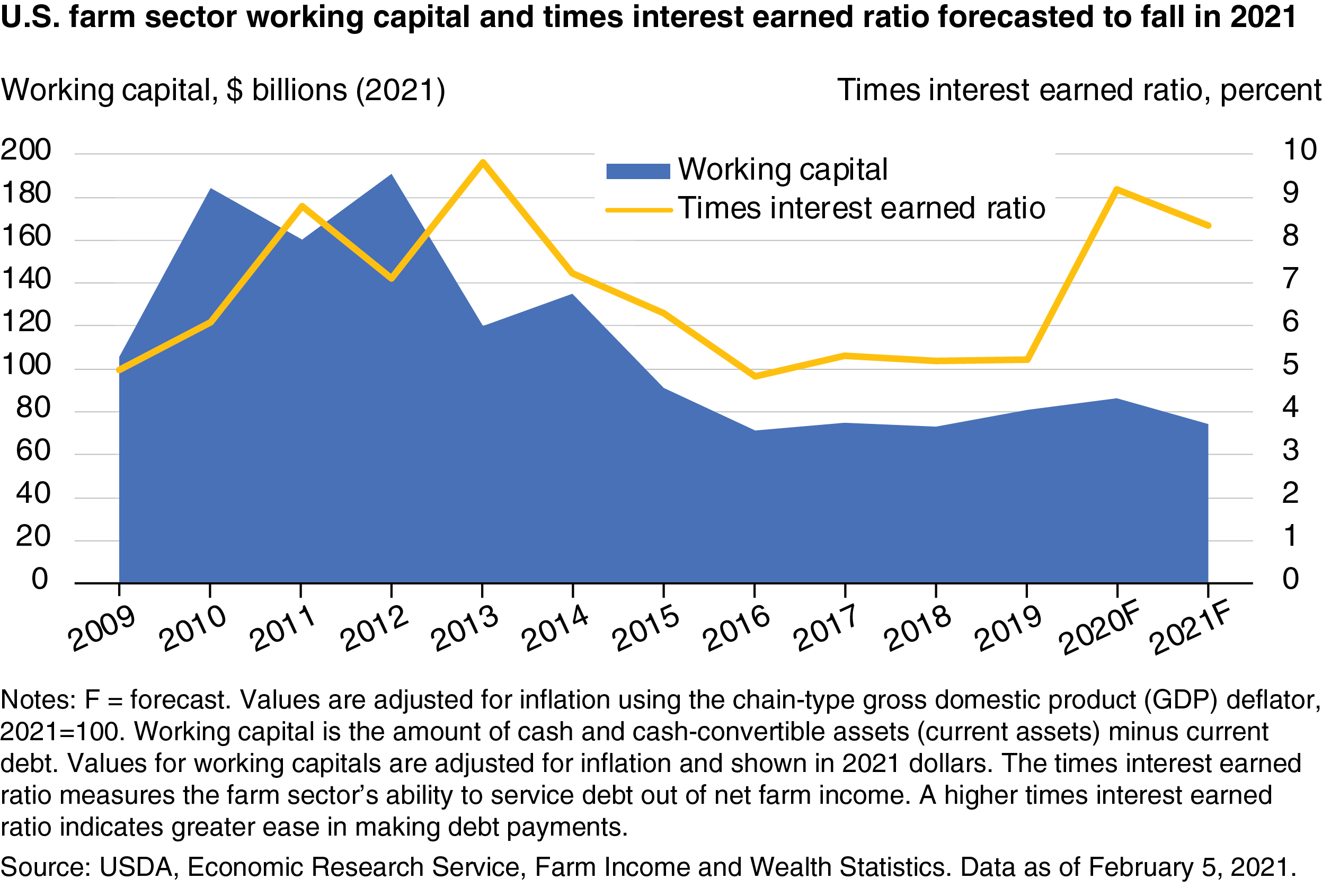
Farm Sector Liquidity Forecast to Decline in 2021
- by Carrie Litkowski
- 3/1/2021
Forecasts from USDA’s Economic Research Service (ERS) show farm sector liquidity declining in 2021, following forecasted general improvement in 2020. Liquidity is the ability to convert assets to cash quickly to satisfy short-term obligations when due, without the assets losing material value. It is one tool for measuring the financial performance of the U.S. farm sector over time. USDA uses several different financial metrics to evaluate farm sector liquidity: working capital, the times interest earned ratio, the current ratio, the debt service ratio, and the ratio of working capital to gross revenues. Each measure of liquidity is different, and this article will focus on working capital and the times interest earned ratio, as they can provide different perspectives. One measures liquidity by looking at the farm sector balance sheet, and the other by looking at the net farm income statement.
Working capital is an absolute measure of the amount of cash available to fund operating expenses after paying off debt to creditors due within 12 months (current debt). It is calculated as the amount of cash and cash-convertible assets (current assets) minus current debt on the farm sector balance sheet. ERS forecasts working capital in 2021 at $74.3 billion, a 13.6-percent decrease from 2020 when values are adjusted for inflation. This reflects an expected decline in current assets with current debt remaining relatively unchanged from 2020. If realized, this would be the largest decline since 2016.
The times interest earned ratio measures the farm sector’s ability to service debt out of net farm income. It is calculated as net farm income, excluding interest expenses, divided by interest expenses. A value less than 1 implies there is not enough cash coming from farm operations to meet interest payments. Without a cash inflow from outside the farm sector, the ability to make interest payments would require borrowing or selling assets. A higher times interest earned ratio indicates greater ease in making debt payments. ERS forecasts the times interest earned ratio to decrease from 9.2 in 2020 to 8.4 in 2021, after a forecasted increase in 2020. The weakening of this ratio in 2021 reflects the forecast decline in net farm income as well as the expected increase in interest expenses. Still, the times interest earned ratio is forecasted to remain above 2014-19 levels.
Both working capital and the times interest earned ratio provide insight into the sector’s near-term ability to keep up with debt. Higher interest expenses and lower net farm income are expected to make it harder for farmers to make debt payments. And, the sector is forecast to have fewer assets that can easily be converted to cash relative to the level of debt that is due within 12 months.
This article is drawn from:
- Farm Income and Wealth Statistics. (n.d.). U.S. Department of Agriculture, Economic Research Service.
You may also like:
- Key, N. (2019, October 22). Larger Farms and Younger Farmers Are More Vulnerable to Financial Stress. Amber Waves, U.S. Department of Agriculture, Economic Research Service.
- Farm Sector Income & Finances. (n.d.). U.S. Department of Agriculture, Economic Research Service.
- Farm Sector Income & Finances - Assets, Debt, and Wealth. (n.d.). U.S. Department of Agriculture, Economic Research Service.
- Lyons, G. (2019). Financial Conditions in the U.S. Agricultural Sector: Historical Comparisons. U.S. Department of Agriculture, Economic Research Service. EIB-211.


